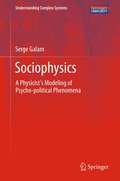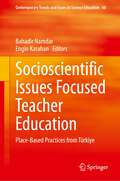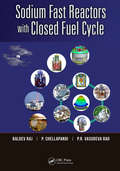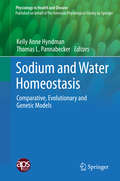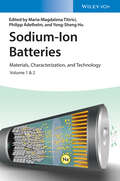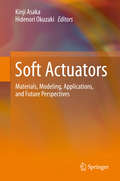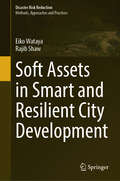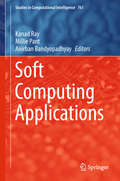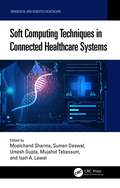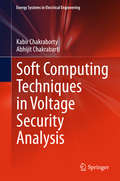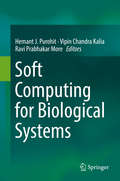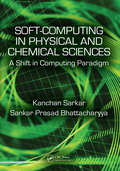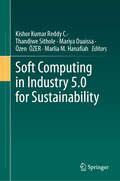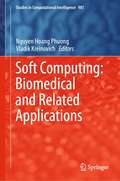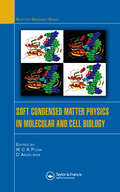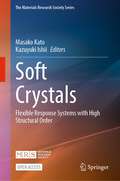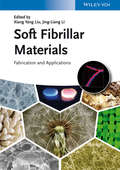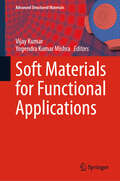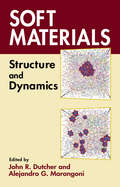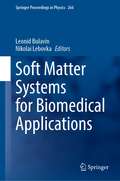- Table View
- List View
Sociophysics
by Serge GalamDo humans behave much like atoms? Sociophysics, which uses tools and concepts from the physics of disordered matter to describe some aspects of social and political behavior, answers in the affirmative. But advocating the use of models from the physical sciences to understand human behavior could be perceived as tantamount to dismissing the existence of human free will and also enabling those seeking manipulative skills . This thought-provoking book argues it is just the contrary. Indeed, future developments and evaluation will either show sociophysics to be inadequate, thus supporting the hypothesis that people can primarily be considered to be free agents, or valid, thus opening the path to a radically different vision of society and personal responsibility. This book attempts to explain why and how humans behave much like atoms, at least in some aspects of their collective lives, and then proposes how this knowledge can serve as a unique key to a dramatic leap forwards in achieving more social freedom in the real world. At heart, sociophysics and this book are about better comprehending the richness and potential of our social interaction, and so distancing ourselves from inanimate atoms.
Socioscientific Issues Focused Teacher Education: Place-Based Practices from Türkiye (Contemporary Trends and Issues in Science Education #60)
by Bahadir Namdar Engin KarahanThis book explores place-based pedagogies in the context of socioscientific issues in Türkiye. From local and global contexts, it delves into research-based learning activities for science teacher educators, offering insights to educators worldwide.The book aims to empower teachers to provide students with learning experiences centered on local socioscientific issues essential for developing scientifically literate citizens. Each chapter showcases effective practices, focusing on local topics like gold mining, nuclear power plants, and river pollution. By incorporating socioscientific elements into science lessons, teachers are encouraged to foster students’ responsibility values, argumentation, critical thinking, and awareness. Emphasizing the crucial components of place-basedness and relevancy of SSI learning environments, students are guided towards more sophisticated ways of conceptualizing and resolving SSI. The intended audience includes science teacher educators, researchers, and educators devoted to engaging students in meaningful socioscientific learning experiences.
Soda-Pop Rockets: 20 Sensational Rockets to Make from Plastic Bottles
by Paul JarvisAnyone can recycle a plastic bottle by tossing it into a bin, but it takes a bit of skill to propel it into a bin from 500 feet away, and this fun guide features 20 different easy-to-launch rockets that can be built from discarded plastic drink bottles. After learning how to construct and launch a basic model, readers find new ways to modify and improve their designs, including built-on fins, nosecones, and parachutes that enable a rocket to float safely back to earth. More complex designs include two-, three-, and five-bottle rockets, gliding rockets, long-tail rockets, cluster rockets, whistling rockets, ring-finned rockets, and a jumbo version made from a five-gallon water-cooler tank. Clear, step-by-step instructions with full-color illustrations accompany each project, along with photographs of the author firing his creations into the sky.
Sodium Fast Reactors with Closed Fuel Cycle
by Baldev Raj P. Chellapandi P.R. Vasudeva RaoSodium Fast Reactors with Closed Fuel Cycle delivers a detailed discussion of an important technology that is being harnessed for commercial energy production in many parts of the world. Presenting the state of the art of sodium-cooled fast reactors with closed fuel cycles, this book:Offers in-depth coverage of reactor physics, materials, design, s
Sodium and Water Homeostasis
by Kelly Anne Hyndman Thomas L. PannabeckerThis book presents cutting edge methods that provide insights into the pathways by which salt and water traverse cell membranes and flow in an orchestrated fashion amongst the many compartments of the body. It focuses on a number of molecular, cellular and whole animal studies that involve multiple physiological systems and shows how the internal milieu is regulated by multifactorial gene regulation, molecular signaling, and cell and organ architecture. Topics covered include: water channels, the urinary concentrating mechanism, angiotensin, the endothelin system, miRNAs and MicroRNA in osmoregulation, desert-adapted mammals, the giraffe kidney, mosquito Malpighian tubules, and circadian rhythms. The book highlights how different approaches to explaining the same physiological processes greatly increase our understanding of these fundamental processes. Greater integration of comparative, evolutionary and genetic animal models in basic science and medical science will improve our overall grasp of the mechanisms of sodium and water balance.
Sodium-Ion Batteries: Materials, Characterization, and Technology, 2 Volumes
by Maria-Magdalena Titirici Philipp Adelhelm Yong-Sheng HuPresents uparalleled coverage of Na-ion battery technology, including the most recent research and emerging applications Na-ion battery technologies have emerged as cost-effective, environmentally friendly alternatives to Li-ion batteries, particularly for large-scale storage applications where battery size is less of a concern than in portable electronics or electric vehicles. Scientists and engineers involved in developing commercially viable Na-ion batteries need to understand the state-of-the-art in constituent materials, electrodes, and electrolytes to meet both performance metrics and economic requirements. Sodium-Ion Batteries: Materials, Characterization, and Technology provides in-depth coverage of the material constituents, characterization, applications, upscaling, and commercialization of Na-ion batteries. Contributions by international experts discuss the development and performance of cathode and anode materials and their characterization - using methods such as NMR spectroscopy, magnetic resonance imaging (MRI), and computational studies - as well as ceramics, ionic liquids, and other solid and liquid electrolytes. Discusses the development of battery technology based on the abundant alkali ion sodium Features a thorough introduction to Na-ion batteries and their comparison with Li-ion batteries Reviews recent research on the structure-electrochemical performance relationship and the development of new solid electrolytes Includes a timely overview of commercial perspectives, cost analysis, and safety issues of Na-ion batteries Covers emerging technologies including Na-ion capacitors, aqueous sodium batteries, and Na-S batteriesThe handbook Sodium-Ion Batteries: Materials, Characterization, and Technology is an indispensable reference for researchers and development engineers, materials scientists, electrochemists, and engineering scientists in both academia and industry.
Sodium: Its Biologic Significance
by PapperSodium is concerned with the physiology, pathophysiology, and clinical consequences of altered physiology involving the sodium ion.The first section focuses on the presence and handling of sodium in the normal state. In chapter one, Drs. Solomon and Galey deal with the fundamentals of transport and energy metabolism as they relate to sodium. This is followed by a chapter in which Drs. Gardenswartz and Schrier consider in detail the normal body economy of sodium, and especially the factors (particularly extracellular fluid volume) that regulate the renal handling of sodium and the responses of the various portions of the nephron to these influences.
Soft Actuators
by Kinji Asaka Hidenori OkuzakiThe subject of this book is the current comprehensive research and development of soft actuators, and encompasses interdisciplinary studies of materials science, mechanics, electronics, robotics and bioscience. As an example, the book includes current research on actuators based on biomaterials to provide future perspectives for artificial muscle technology. Readers can obtain detailed, useful information about materials, methods of synthesis, fabrication and measurements. The topics covered here not only promote further research and development of soft actuators but also lead the way to their utilization and industrialization. One outstanding feature of the book is that it contains many color figures, diagrams and photographs clearly describing the mechanism, apparatus and motion of soft actuators. The chapter on modeling is conducive to more extensive design work in materials and devices and is especially useful in the development of practical applications. Readers can acquire the newest technology and information about the basic science and practical applications of flexible, lightweight and noiseless soft actuators, which are quite unlike conventional mechanical engines and electric motors. The new ideas offered in this volume will provide inspiration and encouragement to researchers and developers as they explore new fields of applications for soft actuators.
Soft Assets in Smart and Resilient City Development (Disaster Risk Reduction)
by Rajib Shaw Eiko WatayaOver the past decade, building smarter, resilient cities is an established global trend in urban development, including developing countries. Unexpected external shocks, disasters and damage from climate change have major impacts on sustainable growth and well-being for citizens in today’s cities and requires comprehensive solutions. To deal with these negative events, cities predominantly invest in hard physical infrastructure, with less attention on non-physical soft assets which are intangible in nature and more difficult to quantify, but essential to achieve effective, balanced sustainable development. The value of soft assets can be substantial, and consistent implementation by cities can generate diverse value and be transformative for their urban development. For that purpose, cities need to establish an appropriate strategy, framework and structure to incorporate soft assets during the plan and implementation of hard infrastructure. This book argues that integrating soft assets in smart, resilient city development is critical to make the hard infrastructure work effectively and create value for cities. The literature review underlines that soft capital can be defined as: 1) human, 2) institutional, 3) external, 4) technology and information, and 5) social. The book also examines how soft assets can be effectively integrated into and create value for smart, resilient city development. Based on previous findings and original research, a unique approach is adopted through the verification of different city-level approaches using the concept of influential nodes, showcasing layered and composite value creation. The analysis addresses innovative implementation factors which enhance disaster resilience and the environment, which is particularly relevant for cities in developing countries. Drawing on previous research, in-depth reviews, new data, and case studies, the book provides new insights and specific policy and action measures to enhance the utilization of soft asset components in parallel with hard infrastructure in smart and resilient city in developing countries.
Soft Computing Applications: Proceedings Of Socta 2016, Volume 1 (Advances In Intelligent Systems And Computing #583)
by Millie Pant Kanad Ray Anirban BandyopadhyayThis book provides a reference guide for researchers, scientists and industrialists working in the area of soft computing, and highlights the latest advances in and applications of soft computing techniques in multidisciplinary areas. Gathering papers presented at the International Conference on Soft Computing: Theories and Applications (SoCTA 2016), which was held in Jaipur, Rajasthan, India, on December 28–30, 2016, it focuses on applying soft computing to solve real-life problems arising in various domains, from medical and healthcare to supply chain management, image processing and cryptanalysis. The term soft computing represents an umbrella term for computational techniques like fuzzy logic, neural networks and nature inspired algorithms. In the past few decades, there has been an exponential rise in the application of soft computing techniques to address complex and intricate problems in diverse spheres of life. The versatility of these techniques has made them a favourite among scientists and researchers alike.
Soft Computing Techniques in Connected Healthcare Systems (Biomedical and Robotics Healthcare)
by Umesh Gupta Moolchand Sharma Mujahid Tabassum Suman Deswal Isah A. LawalThis book provides an examination of applications of soft computing techniques related to healthcare systems and can be used as a reference guide for assessing the roles of various techniques. Soft Computing Techniques in Connected Healthcare Systems presents soft computing techniques and applications used in healthcare systems, along with the latest advancements. The authors examine how connected healthcare is the essence of combining a practical operative procedure of interconnectedness of electronic health records, mHealth, clinical informatics, electronic data exchange, practice management solutions, and pharmacy management. The book focuses on different soft computing techniques, such as fuzzy logic, ANN, and GA, which will enhance services in connected health systems, such as remote diagnosis and monitoring, medication monitoring devices, identifying and treating the underlying causes of disorders and diseases, improved access to specialists, and lower healthcare costs. The chapters also examine descriptive, predictive, and social network techniques and discuss analytical tools and the important role they play in enhancing the services to connected healthcare systems. Finally, the authors address real-time challenges with real-world case studies to enhance the comprehension of topics. This book is intended for under graduate and graduate students, researchers, and practicing professionals in the field of connected healthcare. It provides an overview for beginners while also addressing professionals in the industry on the importance of soft computing approaches in connected healthcare systems.
Soft Computing Techniques in Voltage Security Analysis
by Kabir Chakraborty Abhijit ChakrabartiThis book focuses on soft computing techniques for enhancing voltage security in electrical power networks. Artificial neural networks (ANNs) have been chosen as a soft computing tool, since such networks are eminently suitable for the study of voltage security. The different architectures of the ANNs used in this book are selected on the basis of intelligent criteria rather than by a "brute force" method of trial and error. The fundamental aim of this book is to present a comprehensive treatise on power system security and the simulation of power system security. The core concepts are substantiated by suitable illustrations and computer methods. The book describes analytical aspects of operation and characteristics of power systems from the viewpoint of voltage security. The text is self-contained and thorough. It is intended for senior undergraduate students and postgraduate students in electrical engineering. Practicing engineers, Electrical Control Center (ECC) operators and researchers will also find the book useful.
Soft Computing for Biological Systems
by Vipin Chandra Kalia Hemant J. Purohit Ravi Prabhakar MoreThis book explains how the biological systems and their functions are driven by genetic information stored in the DNA, and their expression driven by different factors. The soft computing approach recognizes the different patterns in DNA sequence and try to assign the biological relevance with available information.The book also focuses on using the soft-computing approach to predict protein-protein interactions, gene expression and networks. The insights from these studies can be used in metagenomic data analysis and predicting artificial neural networks.
Soft Computing for Biomedical Applications and Related Topics (Studies in Computational Intelligence #899)
by Vladik Kreinovich Nguyen Hoang PhuongThis book presents innovative intelligent techniques, with an emphasis on their biomedical applications. Although many medical doctors are willing to share their knowledge – e.g. by incorporating it in computer-based advisory systems that can benefit other doctors – this knowledge is often expressed using imprecise (fuzzy) words from natural language such as “small,” which are difficult for computers to process. Accordingly, we need fuzzy techniques to handle such words. It is also desirable to extract general recommendations from the records of medical doctors’ decisions – by using machine learning techniques such as neural networks. The book describes state-of-the-art fuzzy, neural, and other techniques, especially those that are now being used, or potentially could be used, in biomedical applications. Accordingly, it will benefit all researchers and students interested in the latest developments, as well as practitioners who want to learn about new techniques.
Soft Computing for Data Analytics, Classification Model, and Control (Studies in Fuzziness and Soft Computing #413)
by Oscar Castillo Deepak Gupta Ashish Khanna Aditya KhampariaThis book presents a set of soft computing approaches and their application in data analytics, classification model, and control. The basics of fuzzy logic implementation for advanced hybrid fuzzy driven optimization methods has been covered in the book. The various soft computing techniques, including Fuzzy Logic, Rough Sets, Neutrosophic Sets, Type-2 Fuzzy logic, Neural Networks, Generative Adversarial Networks, and Evolutionary Computation have been discussed and they are used on variety of applications including data analytics, classification model, and control. The book is divided into two thematic parts. The first thematic section covers the various soft computing approaches for text classification and data analysis, while the second section focuses on the fuzzy driven optimization methods for the control systems. The chapters has been written and edited by active researchers, which cover hypotheses and practical considerations; provide insights into the design of hybrid algorithms for applications in data analytics, classification model, and engineering control.
Soft Computing in Chemical and Physical Sciences: A Shift in Computing Paradigm
by Kanchan Sarkar Sankar Prasad BhattacharyyaThis book can be regarded as 'Soft computing for physicists and chemists self-taught'. It prepares the readers with a solid background of soft computing and how to adapt soft computing techniques to problem solving in physical and chemical research. Soft computing methods have been little explored by researchers in physical and chemical sciences primarily because of the absence of books that bridge the gap between the traditional computing paradigm pursued by researchers in science and the new soft computing paradigm that has emerged in computer science. This book is the interface between these primary sources and researchers in physics and chemistry.
Soft Computing in Industry 5.0 for Sustainability
by Mariya Ouaissa Kishor Kumar Reddy C. Thandiwe Sithole Özen Özer Marlia M. HanafiahSoft computing and Industry 5.0 are two distinct concepts that, when combined, can have a significant impact on sustainability initiatives within various industries. Soft computing is a subfield of artificial intelligence (AI) that aims to address problems characterized by uncertainty, imprecision, and partial truth. It encompasses various computational techniques, such as fuzzy logic, neural networks, genetic algorithms, and machine learning, which enable machines to deal with complex and uncertain data in a more human-like manner. Soft computing techniques are particularly valuable in sustainability efforts because they can handle non-linear relationships and uncertain data that often arise in environmental and social contexts. For example, they can be used to optimize energy consumption, waste management, and resource allocation in industries by considering various factors and trade-offs. The book highlights the latest innovations in intelligent systems in classical machine learning, deep learning, Internet of Things (IoT), Industrial Internet of Things (IIoT), blockchain, knowledge representation, knowledge management, big data, and natural language processing. (NLP). The book contains many contemporary articles from both scientists and practitioners working in many fields where soft computing, intelligent systems and the IIoT can break new ground. Intelligent systems and the Internet of Things are now essential technologies in almost every field. From agriculture to industry to healthcare, the scope of smart systems and IIoT is as wide as the horizon. Nowadays, these technologies are extensively used in developed countries, but they are still at an early stage in emerging countries. The primary market of this book is senior undergraduate students, post graduate students, practitioners, researchers, academicians, industrialists, and professionals working in areas of core computer science, electrical engineering, mechanical engineering, environmental engineering and agricultural engineering. The secondary audience of this book is individuals working in the areas of manufacturing, agriculture, remote sensing, environmental engineering, health care, smart cities, smart farming, remote sensing, supply chain management and hydrology.
Soft Computing: Biomedical and Related Applications (Studies in Computational Intelligence #981)
by Vladik Kreinovich Nguyen Hoang PhuongThis book lists current and potential biomedical uses of computational intelligence methods. These methods are used in diagnostics and treatment of such diseases as cancer, cardiac diseases, pneumonia, stroke, and COVID-19. Many biomedical problems are difficult; so, often, the current methods are not sufficient, new methods need to be developed. To confidently apply the new methods to critical life-and-death medical situations, it is important to first test these methods on less critical applications. The book describes several such promising new methods that have been tested on problems from agriculture, computer networks, economics and business, pavement engineering, politics, quantum computing, robotics, etc. This book helps practitioners and researchers to learn more about computational intelligence methods and their biomedical applications—and to further develop this important research direction.
Soft Condensed Matter Physics in Molecular and Cell Biology
by W C K Poon D AndelmanSoft condensed matter physics, which emerged as a distinct branch of physics in the 1990s, studies complex fluids: liquids in which structures with length scale between the molecular and the macroscopic exist. Polymers, liquid crystals, surfactant solutions, and colloids fall into this category. Physicists deal with properties of soft matter system
Soft Crystals: Flexible Response Systems with High Structural Order (The Materials Research Society Series)
by Masako Kato Kazuyuki IshiiThis open access book introduces the science of the new materials, soft crystals, by showing various interesting examples. Different from conventional hard and stable crystals, the soft crystals respond to gentle stimuli such as vapor exposure and rubbing but maintain their structural order. In this book, their exhibition of remarkable visual changes in their shape, color, and luminescence is described. Through the chapters, historical background, recent remarkable developments, and future prospects are described concisely. This book helps readers to understand a new concept of materials that have the characteristics of stimulus-sensitive soft matter and finely controlled crystals and to design novel materials with the characteristics. The English translation of this book from its Japanese language original manuscript was done with the help of artificial intelligence (machine translation by the service DeepL.com). The text has subsequently been revised further by a professional copy editor in order to refine the work stylistically.
Soft Fibrillar Materials
by Xiang Yang Liu Jing Liang LiAs one of the most important classes of soft materials, supramolecular materials are of a mixture of networks of molecular chains/fibrils and a liquid. These self-assembled fibrous/ molecular architectures exhibit various functionalities, ie. superhydrophobicity or superior mechanical strength, etc. and consist of the controllable structures. They can be functioned via micro/nano engineering, to have some particular added functions, ie. emission materials, tissue engineering scaffolds, bio imaging and sensing materials etc. They have therefore found broad applications in photography, cosmetics, food and petroleum industries and not the least in the biomedical sector where there is strong interest in these materials as drug delivery agents.The book covers the most important soft functional materials, including small molecule physical gels, silkworm silk and spider silk fibers and functional fibers, with respect both to the fundamentals and to development and engineering methods. It provides the reader with the necessary knowledge on the chemical and physical formation mechanisms of these materials and demonstrates that one can rationally design and tune the fibrillar networks so that the resulting materials exhibit the desired functionalities.This work is a must-have for all Materials Scientists, Polymer Chemists, Condensed Matter Physicists, and Biotechnologists working in this interdisciplinary field.
Soft Materials for Functional Applications (Advanced Structured Materials #225)
by Vijay Kumar Yogendra Kumar MishraThis book highlights the fundamental and applied properties of different soft functional materials in pure and engineered forms. It presents recent developments in soft materials, such as material synthesis, properties, multicomponent materials engineering, device fabrication, experimental techniques, computational calculations, theoretical outcomes, state-of-the-art characterizations, new technologies, and evaluation of device performance. The chapters in this book are useful for researchers, professionals, policymakers, etc., who are interested and involved in exploring the scope of soft materials in future green and sustainable technologies. The book also includes state-of-the-art review chapters written by well-known specialists in the field and discusses applications in areas such as energy harvesting, soft grippers, robotics, biomimetic devices, drug delivery, surgical devices, smart packaging, and aerospace devices, including self-reporting and self-healing materials.
Soft Materials: Structure and Dynamics
by Alejandro G. Marangoni John R. DutcherRepresenting the wide breadth academic disciplines involved in this ever-expanding area of research, this reference provides a comprehensive overview of current scientific and technological advancements in soft materials analysis and application. Documenting new and emerging challenges in this burgeoning field, Soft Materials is a unique and outsta
Soft Matter Systems for Biomedical Applications (Springer Proceedings in Physics #266)
by Nikolai Lebovka Leonid BulavinThis book addresses new challenges in soft matter and colloids. It presents timely reports on colloidal self-assembly, soft matters from liquid crystals, nanoparticles in liquid crystals, hydrocolloids, hybrid nanosystems, nanosuspensions, and dispersion of nanoparticles in different media, soft matter processing and modern experiments related with soft matters.
Soft Matter at Aqueous Interfaces
by Yi Liu Peter R. LangThis book covers the science of interfaces between an aqueous phase and a solid, another liquid or a gaseous phase, starting from the basic physical chemistry all the way to state-of-the-art research developments. Both experimental and theoretical methods are treated thanks to the contributions of a distinguished list of authors who are all active researchers in their respective fields. The properties of these interfaces are crucial for a wide variety of processes, products and biological systems and functions, such as the formulation of personal care and food products, paints and coatings, microfluidic and lab-on-a-chip applications, cell membranes, and lung surfactants. Accordingly, research and expertise on the subject are spread over a broad range of academic disciplines and industrial laboratories. This book brings together knowledge from these different places with the aim of fostering education, collaborations and research progress.
